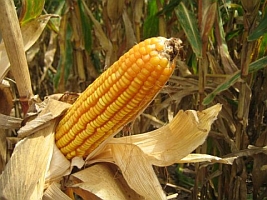Plant scientists at Cold Spring Harbor Laboratory in New York engineered a key gene in maize — called corn in North America — that encourages their version of stem cells to develop more kernels per ear. The findings of David Jackson and colleagues at Cold Spring Harbor appeared online yesterday in the journal Nature Genetics (paid subscription required).
Jackson’s research over the past 10 years involves the role of stem cells in plants called meristems that affect the growth and development of plants, including crops like maize. Meristems respond to genetic signals to develop into plants’ equivalents of organs, such as leaves and flowers that lead to seeds.
The new study investigates the role of meristems in influencing the number of seeds, commonly called kernels, on an ear of maize. “Our simple hypothesis,” says Jackson, “was that an increase in the size of the inflorescence meristem — the stem-cell reservoir that gives rise to flowers and ultimately, after pollination, seeds — will provide more physical space for the development of the structures that mature into kernels.”
In the study, the Cold Spring Harbor team produced a weaker than normal version of a maize gene called Fasciated Ear2, or FEA2, that had been first cloned by Jackson in 2001. The altered FEA2 gene produces a mutated, but still functional signaling protein, which the researchers found increased both the number of rows of kernels and the number of kernels per ear.
Jackson and colleagues grew the test and control maize in two locations. The test maize, with the weakened versions of the FEA2 gene, yielded 18 to 20 rows and up to 289 kernels per ear. By comparison, wild-type versions of the same maize varieties yielded between 14 to 16 rows and 256 kernels per ear. Thus the maize developed with the altered gene increased the number of kernels per ear by 13 percent.
The researchers also grew maize without the FEA2 gene, and found the ears shrunken and deformed. The Cold Spring Harbor team next plans to cross-breed the weak FEA2 gene variant of maize — that produced the increased number of kernels — with the best maize lines used in food crops, to test its ability to produce an even higher-yielding plant.
Read more:
- Arcadia Biosciences to Develop Heat Tolerant Wheat
- International Consortium Studies Corn Genome
- NSF Supporting Research to Reduce Fertilizer Use in Maize
- Grant Funds Research on Developing Corn for Warmer Climate
- Study Highlights Crop Regions At Risk from Climate Change
* * *


 RSS - Posts
RSS - Posts
You must be logged in to post a comment.